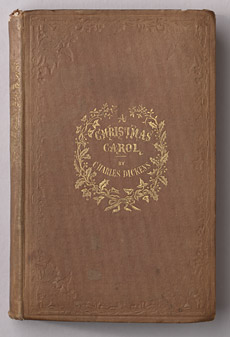UC Berkeley Press Release
 |
Frontispiece of the Bancroft Library's 1843 first edition of Charles Dickens' "A Christmas Carol." (Photos courtesy the Bancroft Library) |
Scholars say Dickens' 'A Christmas Carol' still rings true
BERKELEY – Charles Dickens' Victorian morality tale, "A Christmas Carol," remains a strong influence on contemporary appreciation of the holiday season and, thanks to its many incarnations, has become "one of those stories you know before you remember reading it," says a University of California, Berkeley, English professor.
Ian Duncan, chair of UC Berkeley's English Department and an authority on 19th century British literature, notes that Dickens' story of the redemption of the miserly Ebenezer Scrooge has morphed from an elegant little book marketed in 1843 to British middle-class families into a ubiquitous modern myth presented by filmmaker Frank Capra and via Mr. Magoo, the Mickey Mouse ensemble and the Muppets, among others.
 Dickens' "ghost story of Christmas" has morphed from Victorian morality tale to modern myth. |
The story's premise that even ingrained miscreants can change for the better and that misspent youth can be rectified reassures many people each winter, Duncan says.
The Dickens tale resonates with UC Berkeley students today, says Alan Drosdick, a graduate student who has taught two courses on holiday literature.
The story "absolutely surprises and registers with students as both a nuanced, excellent piece of prose fiction and an affecting piece of social commentary," he says.
Undergraduates usually approach the book with the major plot points and morals deeply ingrained in them since childhood, Drosdick says, yet they are delighted to explore how Dickens effects and manipulates those morals.
In "A Christmas Carol," Dickens seizes on middle-class fears of destitution, poverty and the lack of a government safety net to prevent or ease such predicaments, says Duncan. He notes that Dickens drew on his own experience with a father whose sentence to debtors' prison pushed Dickens into employment at the age of 12. "He (Dickens) would dream of this as an adult," Duncan says.
And Duncan suggests that there was a lot of Dickens in Scrooge, the "snarly, nasty" archetype of winter who Duncan says reflects some of the enterprising author's own ruthless business behavior. Although 6,000 copies of "Carol" were sold the first day it was available, profits for the book with its costly color illustrations and other features failed to live up to Dickens' great financial expectations, experts say.
The disabled Tiny Tim makes a "shamelessly sentimental cameo" in the book, Duncan says, adding to Dickens' pioneering portrayals of children as the victims of unregulated capitalism.
Scrooge sees and corrects the error of his ways after a harrowing visit by the Ghost of Christmas Future shows him dying despised and forgotten. In Capra's compelling but "more narcissistic" version of the fantasy, says Duncan, banker George Bailey decides against a planned suicide after seeing how it would devastate innocent people.
Duncan advises anyone who has not read the story - but who thinks they know it - to pick up the book.
Unlike some classics that are periodically reinvented in literature and on film, the original "A Christmas Carol" by Dickens "really is a masterpiece," he says.
"Re-reading it is like reading 'Treasure Island' again," says Duncan. "You realize that it's stunningly well-crafted by a writer with tremendous economy, vision, passion and clarity."

